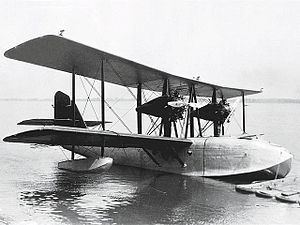Top speed 151 km/h Length 12 m First flight 1929 | Wingspan 17 m Retired 1940 Manufacturer Canadian Vickers | |
 | ||
The Canadian Vickers Vancouver was a Canadian transport/patrol flying boat of the 1930s built by Canadian Vickers.
Contents
It was a twin-engine, equal-span biplane. The hull was of metal and the rest of the structure of fabric-covered wood.
Development
The Vancouver was developed as a replacement for the Varuna in response to a Royal Canadian Air Force requirement for a flying boat to transport men and equipment to forest fires. The main difference from the Varuna was a duralumin hull and more powerful engines. The two flight crew were located in two tandem open cockpits, forward of the wing. The main cabin could accommodate a firefighting team of six men and all the required equipment. Five aircraft were delivered to the Royal Canadian Air Force, one was later converted into a coastal patrol aircraft.
Operational history
In the mid-1930s, the Vancouvers were modified as coastal patrol aircraft by the installation of machine guns and bombs.
After the outbreak of the Second World War, Vancouvers served with 4 Squadron, RCAF at Jericho Beach Air Station until withdrawn from service in 1940. After a brief period of service in training duties, they were finally withdrawn and struck off in 1940.
None of the aircraft saw service after 1940, one private offer to acquire was denied.
Variants
Operator
Specifications (Vancouver IIS)
Data from RCAF.com
General characteristics
Performance
Armament
